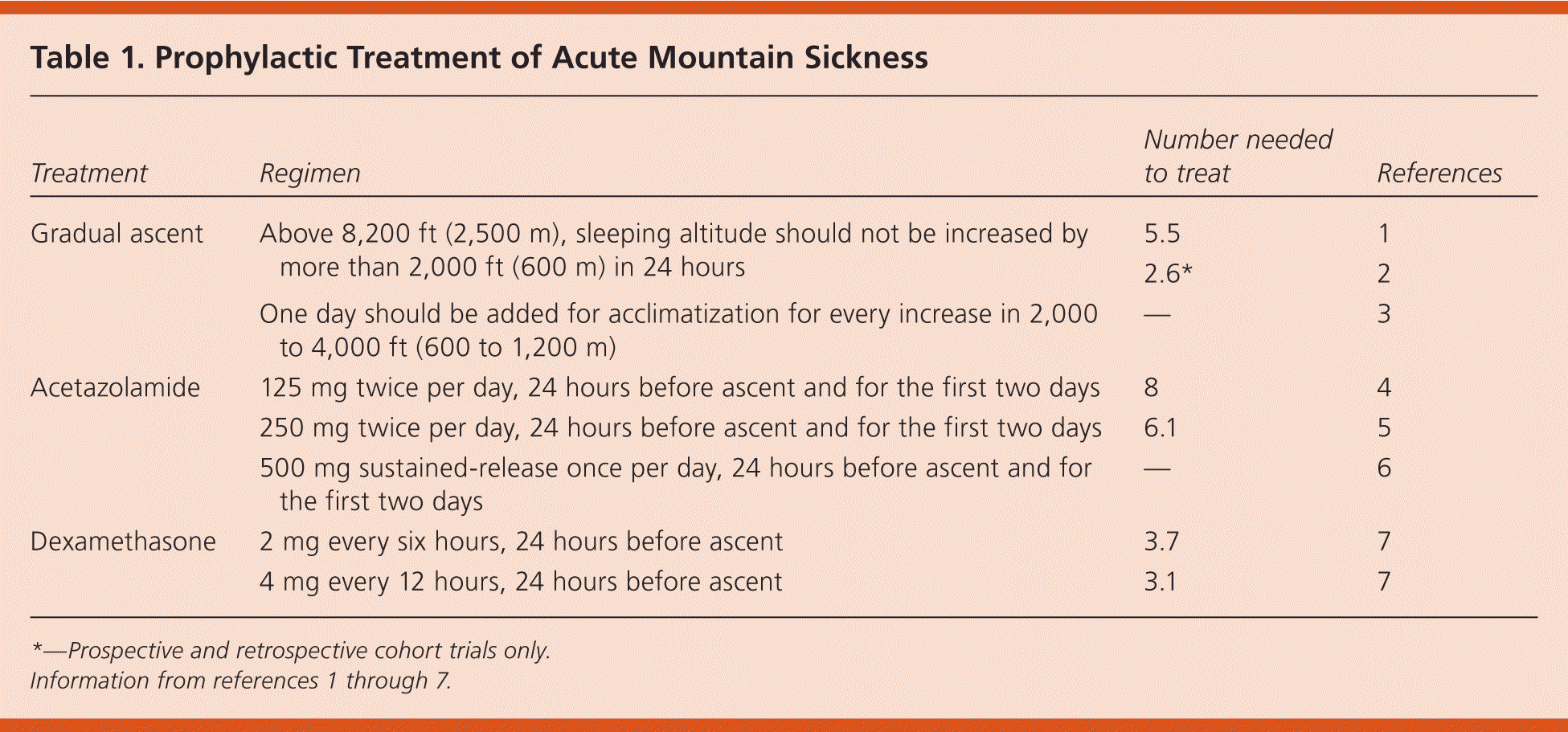
Am Fam Physician. 2011;84(4):398-400
Author disclosure: No relevant financial affiliations to disclose.
Clinical Question
What is the most effective method for preventing acute mountain sickness?
Evidence-Based Answer
Gradual ascent is the most effective method for preventing acute mountain sickness. (Strength of Recommendation [SOR]: B, based on good-quality prospective and retrospective cohort studies.) Acetazolamide should be used to prevent acute mountain sickness in persons with a history of acute mountain sickness or when gradual ascent is not practical. (SOR: A, based on two randomized controlled trials [RCTs] and a meta-analysis of 15 RCTs.) Dexamethasone is effective in preventing acute mountain sickness, but adverse effects must be considered. (SOR: A, based on a meta-analysis of seven RCTs.) Ginkgo extract is not recommended for acute mountain sickness prophylaxis. (SOR: A, based on seven controlled trials.) Recommended prophylactic regimens for acute mountain sickness are listed in Table 1.1–7

| Treatment | Regimen | Number needed to treat | References |
|---|---|---|---|
| Gradual ascent | Above 8,200 ft (2,500 m), sleeping altitude should not be increased by more than 2,000 ft (600 m) in 24 hours | 5.5 | 1 |
| 2.6* | 2 | ||
| One day should be added for acclimatization for every increase in 2,000 to 4,000 ft (600 to 1,200 m) | — | 3 | |
| Acetazolamide | 125 mg twice per day, 24 hours before ascent and for the first two days | 8 | 4 |
| 250 mg twice per day, 24 hours before ascent and for the first two days | 6.1 | 5 | |
| 500 mg sustained-release once per day, 24 hours before ascent and for the first two days | — | 6 | |
| Dexamethasone | 2 mg every six hours, 24 hours before ascent | 3.7 | 7 |
| 4 mg every 12 hours, 24 hours before ascent | 3.1 | 7 |
Evidence Summary
GRADUAL ASCENT
A retrospective cohort study of 278 unacclimatized climbers in the Himalayas found that the incidence of acute mountain sickness in those who walked to an altitude of 9,200 ft (2,800 m) was less than those who flew to the same point (42 and 47 percent for the two walking groups versus 60 and 85 percent for the two flying groups).1 In a prospective cohort study of Indian soldiers, acute mountain sickness symptoms stabilized after three days in those who were transported by road to an altitude of 11,500 ft (3,500 m) compared with five days in those who flew to the same altitude.2 One expert suggests a maximal elevation gain of 2,000 ft (600 m) per day when above 8,200 ft (2,500 m).3
ACETAZOLAMIDE
A double-blind RCT involving 155 trekkers on a slow ascent in Nepal concluded that 125 mg of acetazolamide twice per day was more effective than placebo at reducing the incidence of acute mountain sickness (number needed to treat = 8).4 A double-blind, three-group RCT including 32 vacationers in La Paz, Bolivia, (11,900 ft [3,630 m]) found that prophylactic use of 250 mg of acetazolamide twice per day prevented acute mountain sickness, whereas 125 mg of acetazolamide or placebo twice per day did not produce a statistically significant reduction in the incidence of acute mountain sickness (number needed to treat = 6.1).5 A meta-analysis that included 15 RCTs (n = 805) evaluating acetazolamide concluded that it is effective in preventing acute mountain sickness, although dosing regimens were not the same across trials (effect size = –0.61; 95% confidence interval, –0.29 to –0.93).7
DEXAMETHASONE
The same meta-analysis included seven RCTs (n = 222) evaluating dexamethasone for acute mountain sickness.7 The results showed that dexamethasone is less effective than acetazolamide for preventing acute mountain sickness (effect size = -0.32; 95% confidence interval, 0.38 to –1.02).7 Dexamethasone has the potential to cause serious adverse effects (e.g., depression, glucose intolerance).3,7 Dexamethasone may be considered as first-line therapy when a rapid, unplanned ascent is required, such as in rescue operations.3 Multiple trials have confirmed that dexamethasone is superior to acetazolamide for preventing acute mountain sickness during rapid ascent.7 Multiple dosing regimens have been proposed, but 2 mg every six hours or 4 mg every 12 hours beginning 24 hours before ascent is recommended.3 The literature does not support a specific duration of dexamethasone therapy.
GINKGO
A systematic review of seven placebo-controlled trials (n = 715) identified four trials showing that use of ginkgo extract prevents acute mountain sickness and three trials showing no preventive effect.8 The variability of commercially available ginkgo extract may cause mixed results.8 In two trials, researchers found evidence that the source and composition of the extract may determine the effectiveness of treatment.8 Ginkgo extract may be effective at preventing acute mountain sickness, but because of its complex nature and variability, it is unlikely to be consistently effective. Therefore, it is not recommended as a prophylactic agent.
Recommendations from Others
The Wilderness Medical Society and the Canadian Committee to Advise on Tropical Medicine and Travel recommend gradual ascent as the most effective method of preventing acute mountain sickness.6,9 The Wilderness Medical Society endorses acetazolamide (125 mg twice per day), whereas the Canadian Committee recommends acetazolamide (125 to 250 mg twice per day or 500 mg sustained-release once per day, starting 24 hours before ascent and for the first two days) to prevent acute mountain sickness.6,9 Dexamethasone (2 mg every six hours or 4 mg every 12 hours, starting 24 hours before ascent) is recommended by the Canadian Committee only for the treatment of acute mountain sickness or for prophylaxis in persons who cannot tolerate or who are allergic to acetazolamide. The Wilderness Medical Society endorses dexamethasone (2 mg every six hours or 4 mg every 12 hours) for acute mountain sickness prophylaxis.9
